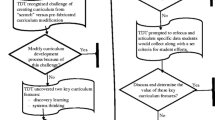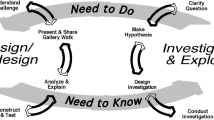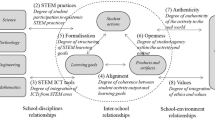Abstract
This chapter presents a multiple case study of design, enactment, and redesign of contextually relevant curricular units reflecting how in-service teachers’ varied understanding of Science, Technology, Engineering and Mathematics (STEM) shaped the curricular units differently. This work originated because of researcher practitioner partnership between a private, international higher education institution at Karachi, Sindh, and a school in Sukkur, Sindh, in Pakistan. During this partnership 18 teachers were engaged in integration of STEM through STEM-focused professional development that was coupled with coaching support using the science and mathematics concepts of grade 4–8 that are in line with the National Curriculum of Pakistan. This research used Design Based Research (DBR) as a methodological approach. Detailed analysis showed the evolution of participant teachers’ STEM conceptions. This study found engineering design challenge as a canvas for the varied level of integration and local contextually relevant problems captivated both teachers and students’ attention. The introduction to STEM offered active learning affordances to teachers and a visible inclusion of some STEM pedagogies was noticed in the classrooms. Participating teachers attributed their engagement in the design, enactment, and redesign of STEM curricular units as a unique hands-on learning that was seen as professional growth opportunity. Finally, this chapter concludes with offering implications for developing teachers’ understanding of STEM for the national level implementation of STEM in Pakistani schools.
Similar content being viewed by others
References
Anwar, T. (2017). Design-based online teacher professional development to introduce integration of STEM in Pakistan. Retrieved from the University of Minnesota Digital Conservancy. http://hdl.handle.net/11299/185626
Bryan, L. A., Moore, T. J., Johnson, C. C., & Roehrig, G. H. (2015). Integrated STEM education. In C. C. Johnson, E. E. Peters-Burton, & T. J. Moore (Eds.), STEM roadmap: A framework for integration (pp. 23–37). Routledge.
Bybee, R. W. (2010). Advancing STEM education: A 2020 vision. Technology and Engineering Teacher, 70(1), 30.
Bybee, R. W. (2013). The case for STEM education: Challenges and opportunities. NSTA Press.
Bybee, R. W. (2019). Using the BSCS 5E instructional model to introduce STEM disciplines. Science and Children, 56(6), 8–12.
Creswell, J. W. (2013). Qualitative inquiry and research design: Choosing among five approaches (3rd ed.). Thousand Oaks: Sage.
Dare, E. A., Ellis, J. A., & Roehrig, G. H. (2018). Understanding science teachers’ implementations of integrated STEM curricular units through a phenomenological multiple case study. International Journal of STEM Education, 5(1), 4.
Dare, E. A., Ring-Whalen, E. A., & Roehrig, G. H. (2019). Creating a continuum of STEM models: Exploring how K-12 science teachers conceptualize STEM education. International Journal of Science Education, 41(12), 1701–1720.
English, L. D. (2016). STEM education K-12: Perspectives on integration. International Journal of STEM education, 3(1), 3.
English, L. D. (2017). Advancing elementary and middle school STEM education. International Journal of Science and Mathematics Education, 15(1), 5–24.
Furner, J. M., & Kumar, D. D. (2007). The mathematics and science integration argument: A stand for teacher education. Eurasia Journal of Mathematics, Science and Technology Education, 3(3), 185–189.
Guzey, S. S., Moore, T. J., & Harwell, M. (2016). Building up STEM: An analysis of teacher-developed engineering design-based STEM integration curricular materials. Journal of Pre-College Engineering Education Research (J-PEER), 6(1), Article 2. https://doi.org/10.7771/2157-9288.1129
Householder, D. L., & Hailey, C. E. (2012). Incorporating engineering design challenges into STEM courses. Publications. Paper 166. https://digitalcommons.usu.edu/ncete_publications/166
Margot, K. C., & Kettler, T. (2019). Teachers’ perception of STEM integration and education: A systematic literature review. International Journal of STEM Education, 6(1), 2.
McKenney, S., & Reeves, T. C. (2012). Conducting educational design research. Routledge.
Moore, T. J., & Smith, K. A. (2014). Advancing the state of the art of STEM integration. Journal of STEM Education: Innovations and Research, 15(1), 5.
Moore, T. J., Stohlmann, M. S., Wang, H. H., Tank, K. M., Glancy, A. W., & Roehrig, G. H. (2014). Implementation and integration of engineering in K-12 STEM education. In Ş. Purzer, J. Strobel, & M. E. Cardella (Eds.), Engineering in pre-college settings: Synthesizing research, policy, and practices (pp. 35–60). Purdue University Press.
Moore, T. J., Johnson, C. C., Peters-Burton, E. E., & Guzey, S. S. (2015). The need for a STEM road map. In STEM road map (pp. 3–12). Routledge.
Nadelson, L. S., & Seifert, A. L. (2017). Integrated STEM defined: Contexts, challenges, and the future. The Journal of Educational Research, 110(3), 221–223. https://doi.org/10.1080/00220671.2017.1289775
National Curriculum Framework. (2017). Retrieved from http://mofept.gov.pk/SiteImage/Policy/NCF-mfept.pdf
Radloff, J., & Guzey, S. (2016). Investigating preservice STEM teacher conceptions of STEM education. Journal of Science Education and Technology, 25(5), 759–774.
Ring, E. A., Dare, E. A., Crotty, E. A., & Roehrig, G. H. (2017). The evolution of teacher conceptions of STEM education throughout an intensive professional development experience. Journal of Science Teacher Education, 28(5), 444–467.
Ritz, J. M., & Fan, S. C. (2015). STEM and technology education: International state-of-the-art. International Journal of Technology and Design Education, 25(4), 429–451.
Single National Curriculum. (2020). Retrieved from http://mofept.gov.pk/ProjectDetail/MzkyNDc2MjMtY2VjYy00ZDA4LTk5OTUtNzUyNDI3ZWMzN2Rm
The News. (2019). Retrieved from https://www.thenews.com.pk/latest/488302-stem-schools-to-be-established-in-pakistan-fawad-chaudhry
The News. (2020a). Retrieved from https://www.thenews.com.pk/print/647297-towards-a-stem-revolution
The News. (2020b). Retrieved from https://www.thenews.com.pk/magazine/you/611861-bridging-the-stem-gap
Vasquez, J. A. (2015). STEM – Beyond the acronym. Educational Leadership, 72(4), 10–15.
Acknowledgments
This study was made possible by the Aga Khan University’s URC Grant # 182014. The findings, conclusions, and opinions herein represent the views of the authors.
Author information
Authors and Affiliations
Corresponding author
Editor information
Editors and Affiliations
Section Editor information
Rights and permissions
Copyright information
© 2023 Springer Nature Switzerland AG
About this entry
Cite this entry
Anwar, T., Siddiqi, U. (2023). Transfer of STEM Research for Designing Contextually Relevant Curriculum in Pakistan: A Case Study. In: Spector, M.J., Lockee, B.B., Childress, M.D. (eds) Learning, Design, and Technology. Springer, Cham. https://doi.org/10.1007/978-3-319-17727-4_190-2
Download citation
DOI: https://doi.org/10.1007/978-3-319-17727-4_190-2
Received:
Accepted:
Published:
Publisher Name: Springer, Cham
Print ISBN: 978-3-319-17727-4
Online ISBN: 978-3-319-17727-4
eBook Packages: Springer Reference EducationReference Module Humanities and Social SciencesReference Module Education
Publish with us
Chapter history
-
Latest
Transfer of STEM Research for Designing Contextually Relevant Curriculum in Pakistan: A Case Study- Published:
- 10 January 2023
DOI: https://doi.org/10.1007/978-3-319-17727-4_190-2
-
Original
Transfer of STEM Research for Designing Contextually Relevant Curriculum in Pakistan: A CASE STUDY- Published:
- 15 December 2022
DOI: https://doi.org/10.1007/978-3-319-17727-4_190-1




